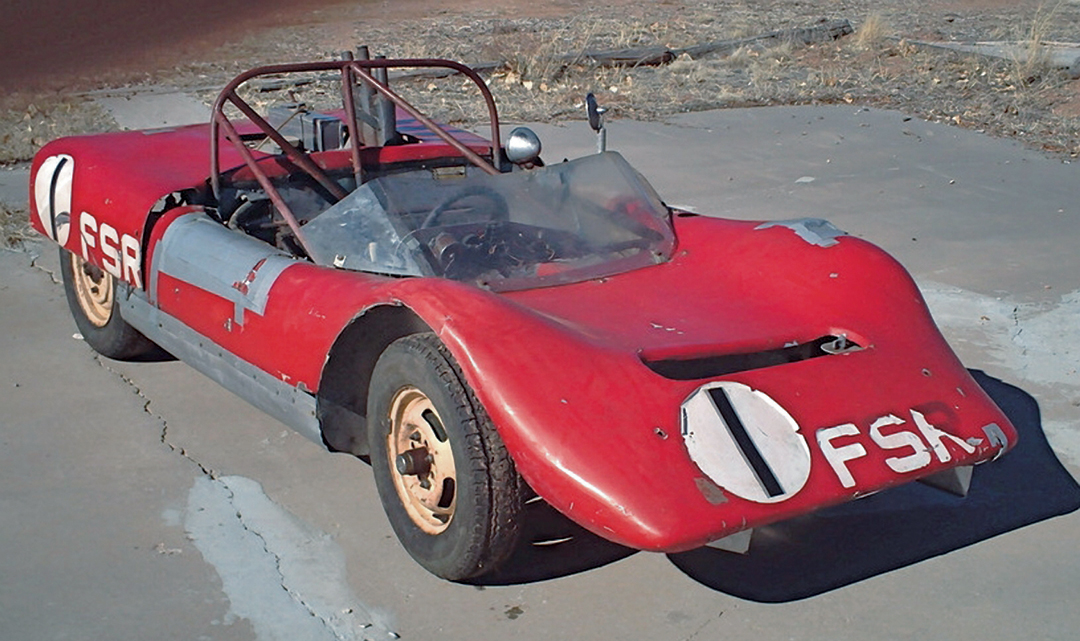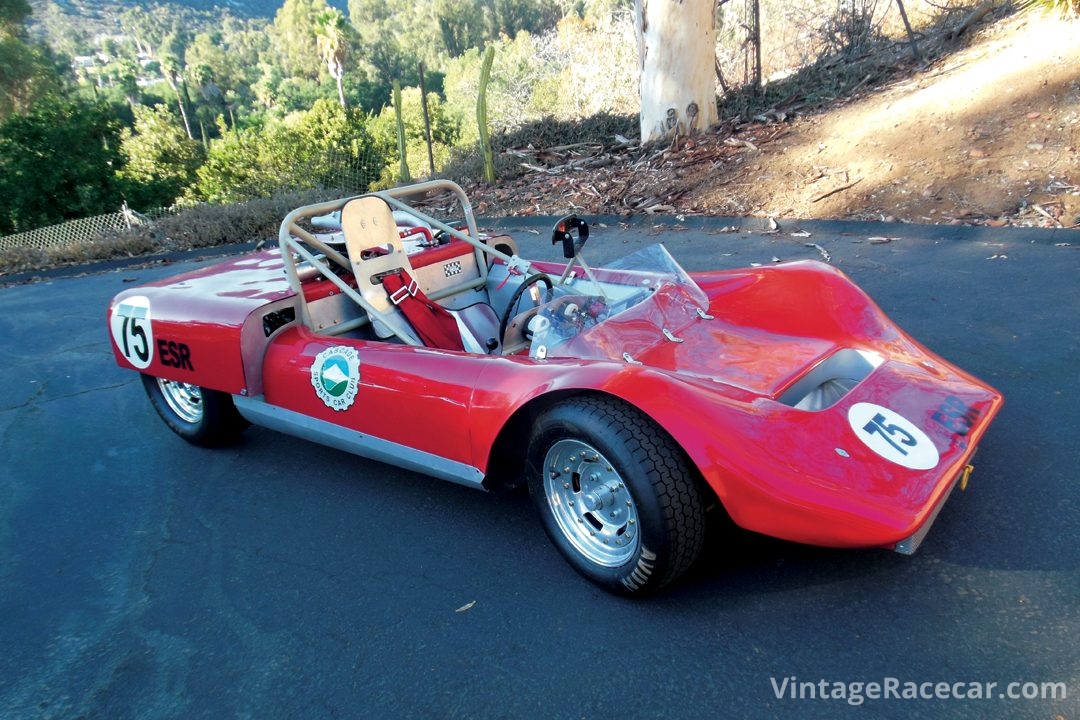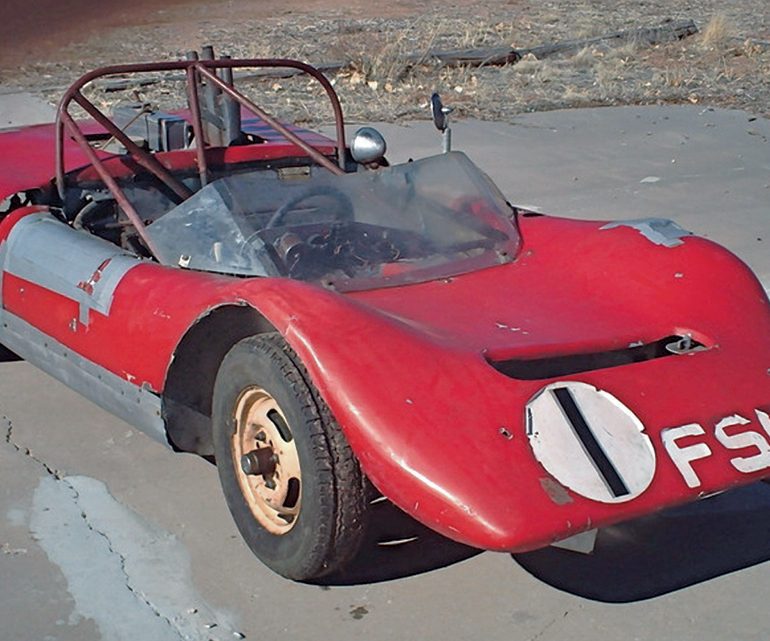How many vintage racing machines can you name that were originally powered by an ear-piercing DKW power plant? Not such an easy question, but I’m able to recall a few. In the Formula Junior class, there was Erick Sobriery’s 1959 FJ and Lyle Powell’s 1960 FJ, both well-constructed one-offs with hand-formed aluminum bodies. Haverford Sport Motor (HSM) produced at least one and perhaps as many as three DKW-powered FJs, and Zeitler Racing Design built one Zeter Mk. 1 and four Zeter Mk. 2 FJs with DKW engines. In the sports racer realm, Bobsy built an SR1 motivated by a DKW engine, and Zink built two (or three) DKW Petits and at least one DKW-driven Z-4.
I’ve just recently been made aware of another sports racer that competed with DKW muscle and was built in the 1960s. The constructors were a group of students attending Portland’s Benson Polytechnic High School and the project was supervised by Jim Hurd. To the best information available, the teenagers did most of the work.
The build began with fabrication of a tubular spaceframe executed with both round and square members. Front suspension was by unequal length wishbones with BSA motorcycle coilovers. Rear suspension was by unequal length wishbones. Brakes were Morris Minor drums up front and DKW Junior drums at the rear. The body was built by the students and was of hand-laid fiberglass/polyester resin construction using fiberglass mat and cloth. For power, the students selected a three-cylinder, two-stroke DKW engine sourced from a DKW Junior. With so many engines to choose from, one might wonder why they selected DKW.

Dampf-Kraft-Wagen (DKW) was a German automobile and motorcycle manufacturer whose roots can be traced to 1916. Starting in the 1920s and into the ’30s, DKW won a string of international motorcycle championships with its innovative two-stroke engines. This era was highlighted by Ewald Kluge’s victory in the Lightweight TT Class (250-cc) at the 1938 English Touring Trophy event at the Isle of Man, where his rotary-valve bike came home 11 minutes, 10 seconds faster than the 2nd-place finisher. Post-war—and following the 1932 merger with Audi, Wanderer and Horch to create Auto Union—DKW two-stroke motorbikes continued to win championship after championship.
There were also early DKW-powered racecars. Perhaps the earliest competitive DKW automobile was seen at the 1929 Monte Carlo rally where Gerhard Macher and Gustav Menz piloted a 600-cc two-cylinder job. During the 1930s, DKW racing cars contested a wide array of road racing and hillclimb events. The cars were built in both front- and rear-wheel drive configurations, and were powered by engines ranging from two-cylinder, two-strokes to four-cylinder units. The cars raced at a variety of venues including the Nürburgring, Avus, the Liege-Rome-Liege Alpine Rally and numerous hillclimbs.
An important development came in 1953 when the marque introduced the front-wheel drive, three-cylinder, two-stroke DKW 3=6 (“Sonderklasse”) model displacing 896-cc. With confidence-inspiring handling and a zippy engine, motorheads began to race this new machine with great enthusiasm. The car was so good, the following year (1954), Walter Schlüter captured the European Rally Championship behind the wheel of a front-wheel drive DKW 3=6 Sonderklasse. Over the next decade, the three-cylinder, two-stroke DKWs scored hundreds of class wins and even set land speed records at Monza. The engine size steadily grew to 1000-cc with the best builders achieving an astonishing 100-bhp. The potent DKW two-stroke could be pushed to the max without fear of burnt valves (the engine had none), but exploded eardrums was a potential consequence as the appliance was mega-loud.

To the best information available, Cal Watson of Tigard, Oregon, owned the Benson Polytechnic High School DKW Special from 1965 to 1990. Dick Boggs of Seattle, Washington, acquired the car from Watson’s estate in 1990. In 2006, Larry Haynes of Santa Fe, New Mexico, became the car’s next custodian, but soon thereafter passed the car to Dave Perry of OldSchool Restorations in North Alabama. Ultimately, the car landed in the possession of David Lambert of Escondido, California, who has owned it since 2011.
Lambert is a retired professor who has had an interest in sports and racing cars since his early teens. He autocrossed in the 1970s and ’80s and has been vintage racing H-Modifieds with VARA and SVRA since 2007. Lambert said, “Since retirement, my principal activity has been to restore and race vintage cars. In 2011, I was between projects as my Crosley-Fiat Special was complete and the bugs that’d been causing DNFs had largely been sorted. I was looking for a missing piece to my next project, an Almquist Sabre fiberglass body without a chassis. I sent out a number of email inquiries looking for a chassis and Dave Perry of OldSchool Restorations replied that he had a project that might work with the body I had. Looking at the pictures he sent, I realized that the chassis from his mid-engine racer would not work with the Almquist body, but his car was intriguing on its own merits. So I made the decision to move the Almquist body back in the queue and start on the DKW Special.”
Lambert continued, “The car was raced by Cal Watson from 1965 to 1983 in Cascade Sports Car Club (CSCC) events. CSCC is sanctioned by the International Conference of Sports Car Clubs (ICSCC) and Watson became the second president of ICSCC in 1959. Since 2011, I’ve been able to document that Watson won his class championship at least two years, was 2nd once, and 3rd once. The car was known as the DKW Special and raced as Number 1 in class FSR, for sports racing cars under one liter. I continue to look for photographs of Cal Watson and the car as raced with CSCC, and I am happy to be contacted at [email protected].”
When Lambert received the car in 2011 it was largely intact but in rough condition from outside storage. He reports that the chassis following restoration is mostly original with significant rust repair to the lower frame tubes. He replaced the belly pan, bulkheads and inner fenders because of their poor state. Lambert constructed a mold from the damaged original body and produced a new one of fiberglass polyester composites, retaining the original body for historical purposes. The original three-cylinder, two-stroke DKW was filled with water and unrepairable. For now, Lambert has swapped in a similarly conceived Saab three-banger, two-stroker.
Lambert plans to vintage race his mid-engine screamer and will follow in the long line of three-cylinder, two-stroke fanatics. Although for the time being his right foot will be summoning Swedish, not German, power, the noise will most certainly be equally deafening.




